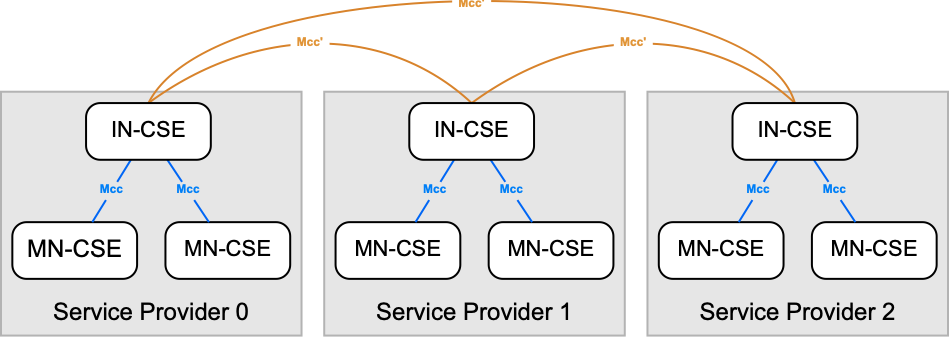How to Interconnect Service Providers
A normal oneM2M deployment consists of a set of oneM2M nodes that are connected to each other in a tree-like structure, consisting of a root infrastructure node (IN-CSE) and several child nodes that can be either middle nodes (MN-CSE), application service nodes (ASN-CSE), or application dedicated nodes (ADN-CSE).
Service Provider Registrations
oneM2M defines a mechanism to interconnect different oneM2M deployment trees. This is done by registering an IN-CSE of one service provider deployment with an IN-CSE of another service provider deployment. This can be done multiple times, allowing a node to connect to multiple other nodes.
The following figure illustrates this concept.
The CSEs of a single service provider can register with each other via the Mcc reference point (the blue connections in the figure). The top-level IN-CSE of each service provider can then regiser itself with the IN-CSE of another service provider via the Mcc'1 reference point (the orange connections in the figure).
Registrations are uni-directional
A registration between the IN-CSEs of different service providers is a uni-directional process. This means that the registration from one service provider to another only happens in one direction. The other service provider's IN-CSE must not register with the first service provider's IN-CSE.
After the registration is successful, the two IN-CSEs can exchange information about their CSEs and resources. This allows the CSEs of one service provider to access resources of the other service provider's CSEs, as long as the remote CSEs allow this via their access control policies.
Configuration
The configuration of the service provider registration is done in a similar way as a configuration to a normal registrar CSE within a single oneM2M deployment.
The difference is that one needs to specify one or two sections in the configuration file. The name of each section is important, as it is used to distinguish the different service provider registrations. The section names must start with cse.sp.registrar. followed by a unique identifier for that particular service provider registration.
In the examples below, we use "Service Provider 1" as the local service provider, and "Service Provider 2" as the remote service provider that we want to register with. Remember, the second service provider's IN-CSE must not register with the first service provider's IN-CSE.
More details about these configuration settings can be found in the configuration documentation for Service Provider Registrations and Service Provider Security.
Service Provider Section
There must be at least one configuration section for the service provider registration itself, which contains the information about the remote IN-CSE.
A minimum configuration section for a service provider registration could look like this:
[cse.sp.registrar.exampleProvider1]
; The remote IN-CSE's service provider ID, address, CSE ID, resource name and serialization format
spID = //provider-2.example.com
address = https://provider-2.example.com:8080
cseID = /id-in-sp2
resourceName = cse-in-sp2
serialization = json
Security Section
Optionally, a second section can be provided to specify security information for connecting to the remote IN-CSE, such as the security scheme and credentials.
An example security section for the service provider connection specified above that uses HTTPS with a self-signed certificate and basic authentication could look like this:
[cse.sp.registrar.exampleProvider-2.security]
; This is our user name and password that we use to authenticate with the remote IN-CSE
httpUsername = sp-1-User
httpPassword = hashedPassword-1
; This is the user name and password that the remote IN-CSE uses to authenticate with us
selfHttpUsername = spUser1-2
selfHttpPassword = hashedPassword-2
Authorize Service Provider Registrations
As with every registration, the registering CSE (Service Provider 1) must be authorized to register with the remote IN-CSE (Service Provider 2). This is done by adding the CSE's ID of Service Provider 1 to the allowedCSROriginators setting in the [cse.registration] section of Service Provider 2's configuration file:
[cse.registration]
allowedCSROriginators=//provider-1.example.com/id-in-sp1
allowedCSROriginators is a list of CSE IDs, and may contain multiple entries, separated by commas. Each entry must be a valid CSE ID in absolute or SP-relative form.
What about the registrar CSE's ID?
The registrar CSE's (Service Provider 2) ID does not need to be added to the local CSE's (Service Provider 1) allowedCSROriginators setting.
This ID is added implicitly when the registration is successful.
-
Mcc' is pronounced "Mcc prime" ↩
